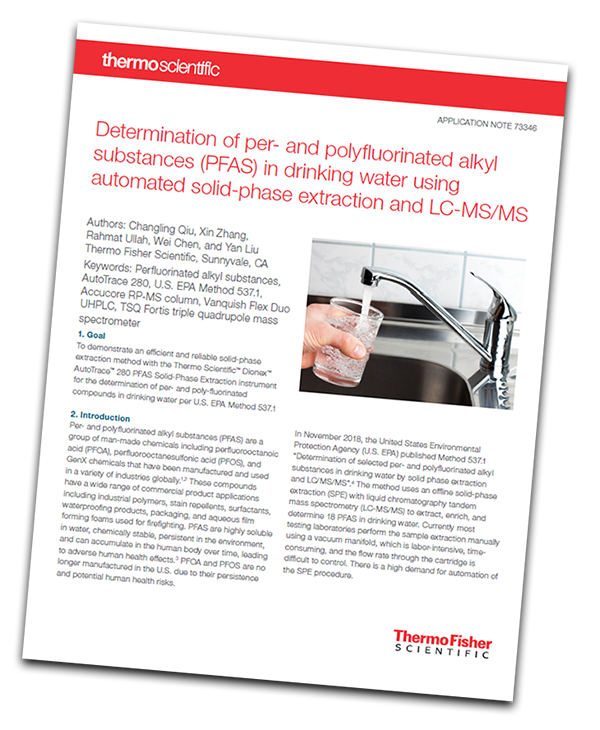This application note demonstrates reliable solid-phase extraction with the Thermo Scientific™ Dionex™ AutoTrace™ 280 PFAS SPE for the determination of per- and poly-fluorinated compounds in drinking water per U.S. EPA Method 537.1.
 Goal
Goal
To demonstrate an efficient and reliable solid-phase extraction method with the Thermo Scientific™ Dionex™ AutoTrace™ 280 PFAS Solid-Phase Extraction instrument for the determination of per- and poly-fluorinated
compounds in drinking water per U.S. EPA Method 537.1.
Introduction
Per- and polyfluorinated alkyl substances (PFAS) are a group of man-made chemicals including perfluorooctanoic acid (PFOA), perfluorooctanesulfonic acid (PFOS), and GenX chemicals that have been manufactured and used
in a variety of industries globally. These compounds have a wide range of commercial product applications including industrial polymers, stain repellents, surfactants, waterproofing products, packaging, and aqueous film forming foams used for firefighting. PFAS are highly soluble in water, chemically stable, persistent in the environment, and can accumulate in the human body over time, leading to adverse human health effects. PFOA and PFOS are no longer manufactured in the U.S. due to their persistence and potential human health risks.
In this application note, we discuss the development of an analytical method using an automated SPE system, AutoTrace 280 PFAS, and LC-MS/MS for determination of eighteen PFAS following the guidelines provided by U.S. EPA Method 537.1. We have demonstrated that the AutoTrace 280 PFAS instrument provides reliable automated SPE for determination of PFAS in large-volume (20 mL–4 L) aqueous samples.
Experimental
Full details of the experimental conditions can be found by downloading the application note.
Results and Discussion
LC-MS/MS chromatograms of 4 μg/L PFAS standards demonstrate that all the analytes are detected in 15 min and peak asymmetry factors are within 0.8–1.2, meeting the U.S. EPA Method 537.1 requirement.
A low system background needs to be demonstrated before running the samples. This is to ensure that no potential background contaminants interfere with the identification or quantitation of method analytes. The minimum reporting level (MRL) of U.S. EPA Method 537.1 for the 18 PFAS is 0.53–6.3 ng/L. The interference from solvents, reagents, containers, and SPE instrument needs to be maintained below 1/3 of the MRL value. Interference can come from contaminants of similar properties and also from the analytes that are present in many common laboratory supplies and SPE devices. The EPA method emphasizes that care must be taken with automated SPE systems to ensure that PFAS safe material used in these systems does not contribute to unacceptable analyte concentrations in the blank test.
Conclusion
This application note reports a method that can be used for the extraction and determination of 18 PFAS in drinking water with a PFAS-safe AutoTrace 280 extraction system and LC-MS/MS. The modified AutoTrace 280 extraction system ensures inertness and prevents PFAS from leaching into sample during extraction, while at the same time delivering consistent and reliable performance. Both sample path cleaning in SPE and separation method precaution for the LC system maintained a low system background, meeting the EPA method requirement. The calculated LCMRLs ranged from 0.20 to 3.5 ng/L and the MDLs ranged from 0.30 to 2.5 ng/L, which were below or comparable to those values reported in U.S. EPA Method 537.1. At both 16.0 ng/L and 80.0 ng/L fortified concentration levels, all the recoveries were within the acceptable range of 70–130%. The calculated RSDs were all less than 10%, suggesting good precision. Thermo Scientific LC-MS/MS with the automatic extraction AutoTrace 280 PFAS system demonstrated an efficient, reliable, and sensitive method to fulfill the requirements of U.S. EPA Method 537.1.
